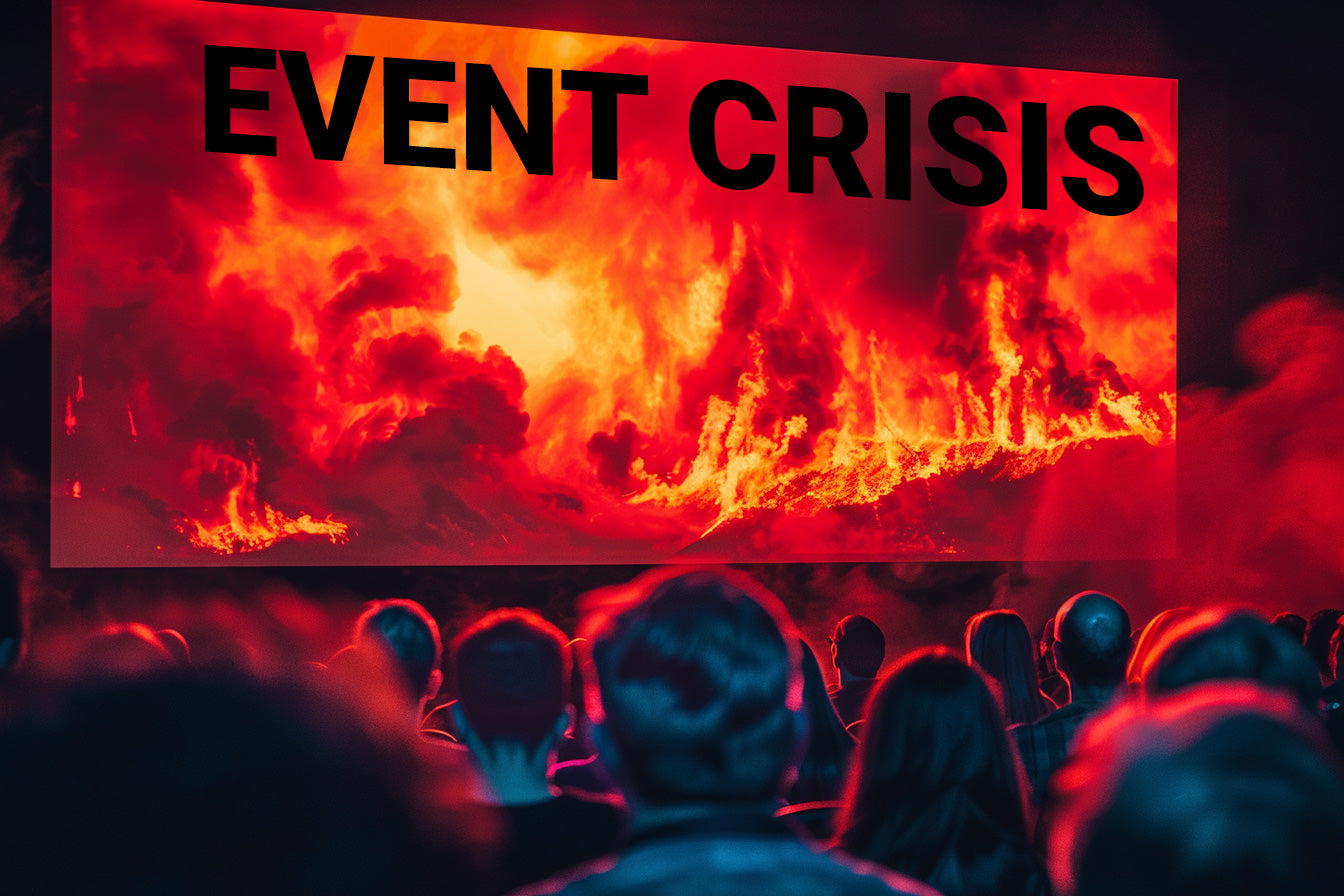Purpose
The purpose of this exercise is to sharpen crisis management skills within the context of hospitality and event management. Delegates will experience the unpredictability and pressure of managing a large event during a crisis. The focus is on enhancing their abilities in calm and decisive leadership, effective communication and rapid problem-solving.
Objective
Delegates will be divided into groups, assuming roles in a scenario where they must manage a crisis at a large event, such as a sudden weather event, a keynote speaker cancellation or a power outage. The objective is for each team to quickly devise and execute a response plan that covers stakeholder communication, contingency planning and resource reallocation.
What You Need
- Scenario cards detailing different crises. A series of Crisis Scenario Cards are provided below.
- Role cards assigning specific responsibilities within the team. These can be Event Coordinator, Communication Officer, Logistics Manager, etc.
- A timer or stopwatch.
- Materials for creating a response plan such as flip chart, markers and sticky notes.
Setup
- Prepare Crisis Scenario Cards in advance, each describing a different crisis situation that could realistically occur during a large event.
- Create role cards for various positions within an event management team, such as Event Coordinator, Communication Officer, Logistics Manager, etc.
- Arrange the classroom into small groups of 4 delegates. If there is an odd number of delegates, one group can have 5 members, ensuring no one is left out.
- Within each group, distribute the role cards so that each delegate assumes a specific position within the event management team.
- Hand out a Crisis Scenario Card to each group. Each group should receive a different scenario to ensure a variety of learning experiences.
- Explain the objectives and expected outcomes of the scenario to each group. Clarify any questions regarding the roles or the crisis situation outlined on their scenario card.
- Provide each group with materials needed to create their response plan, such as flip charts, markers, and sticky notes. These materials will help them brainstorm, plan and present their solutions.
- Get groups to go through role-plays within their teams based on their response plan.
- Allocate about 20-30 minutes for the exercise (see breakdown below).
- Bring everyone back together and ask each group to briefly present their scenario and their approach to the rest of the class.
- Encourage everyone to discuss each group’s approach after they present them.
- Follow with a general discussion.
Timing
Explaining the Exercise: 5 minutes
Activity: 20-30 minutes
- Role Assignment and Scenario Briefing: 5 minutes
- Developing the Response Plan: 10-15 minutes
- Role-Playing the Implementation: 5-10 minutes
Group Feedback:
- Discussion for each group: 5 minutes for each group
- Overall summary and conclusions: 10 minutes
Discussion
After the exercise, lead a discussion to reflect on the experience and lessons learned. Pose the following questions to the delegates:
- How did you prioritise your initial actions in response to the crisis?
- In what ways did effective communication play a role in your team’s response?
- How did you adapt your plan to accommodate the unexpected elements of the scenario?
- Reflect on the leadership observed during the exercise. What styles were most effective and why?
- How could the response plan have been improved with more time or resources?
- What lessons can you take from this simulation to apply in real-world event management?
Scenario Cards for Crisis Management Exercise
These scenario cards are designed to challenge delegates and help you train them on crisis management across various competencies such as: brainstorming, decision-making, problem-solving, team building, leadership, resource management, event planning and change management.
1. Sudden Weather Event
A severe storm warning is issued an hour before the outdoor event starts, threatening safety and the event’s continuation. You must decide on immediate actions to protect attendees and whether to relocate, postpone or cancel the event.
2. Keynote Speaker Cancellation
The keynote speaker for the conference cancels last minute due to a medical emergency. You need to quickly find a replacement speaker, adjust the event schedule and communicate changes to attendees without causing panic or dissatisfaction.
3. Power Outage
A sudden power outage occurs at the venue during the event, affecting lighting, heating, and audio-visual equipment. You must manage the situation to ensure safety, keep attendees informed, and find alternative solutions to continue the event smoothly.
4. Security Threat
A potential security threat is reported near the event location, raising concerns among attendees and staff. You need to assess the threat level, decide on appropriate security measures, and communicate effectively with everyone involved to maintain calm and order.
5. Venue Double-Booking
It is discovered on the event day that the venue has been double-booked. You have to negotiate with the venue management and the other party, considering options like schedule adjustments, shared spaces, or finding a last-minute alternative venue.
6. Technology Failure
The online registration and check-in system crashes on the morning of the event, causing delays and confusion. You must quickly implement a manual process, manage attendee frustrations, and troubleshoot the system issues.
7. Catering Mishap
The caterer fails to deliver the food on time, leaving you without meals for a gala dinner. You need to find an immediate solution to feed the attendees, manage their expectations, and handle the situation with the catering service.
8. VIP Guest Incident
A VIP guest has a medical emergency during the event. You must ensure they receive prompt medical attention while minimising disruption to the event and maintaining the privacy and comfort of the VIP and other attendees.
9. Negative Social Media Coverage
During the event, negative reviews and comments start spreading on social media, potentially damaging the event’s reputation. You need to monitor the situation, engage positively with the online community, and address any real-time issues that are causing dissatisfaction.
10. Environmental Protest
An environmental group starts a peaceful protest outside the venue, drawing media attention and potentially disrupting access. You have to manage attendee and staff safety, liaise with law enforcement, communicate with the protesters, and ensure the event continues with minimal disruption.
Soft Skills Training Materials
Get downloadable training materials
Online Train the Trainer Course:
Core Skills
Learn How to Become the Best Trainer in Your Field
All Tags
Training Resources for You

Course Design Strategy
Available as paperback and ebook

Free Training Resources
Download a free comprehensive training package including training guidelines, soft skills training activities, assessment forms and useful training resources that you can use to enhance your courses.

Our Comprehensive Guide to Body Language

Train the Trainer Resources
Get Insights - Read Guides and Books - Attend Courses
Training Materials
Get downloadable training materials on: Management Training, Personal Development, Interpersonal Development, Human Resources, and Sales & Marketing














1 comment
raghavan
very well documented and good learning eercise
Leave a comment
All comments are moderated before being published.
This site is protected by hCaptcha and the hCaptcha Privacy Policy and Terms of Service apply.